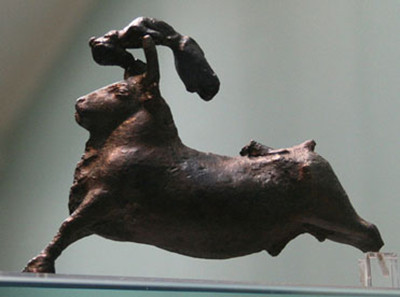Archaeologists were captivated by these tales and, just over a hundred years ago, when Arthur Evans explored the island and decided to dig at Knossos, the bulls and monsters, palaces and labyrinths of Crete, familiar from Greek myth, were still very much in his mind.
迷人的傳說吸引著考古學家。一百多年前,亞瑟埃文斯開始在克諾索斯進行考古發掘的時候,公牛、野獸、克里特的宮殿與迷宮在他的腦海里盤桓不去。
So although we have no idea what the people of this rich civilisation around 1700 BC actually called themselves, Evans, believing he was uncovering the world of Minos, called them quite simply Minoans, and Minoans they've remained ever since.
我們不知道這一公元前一千七百年的發達文明中人們 如何稱呼自己,但亞瑟堅信自己發掘的是米諾斯的世界,便將他們稱為米諾斯人,從此考古學界便沿用了這一稱呼。
In his extensive excavations, Evans uncovered the remains of a vast building complex; finding pottery and jewellery, carved stone seals, ivory, gold and bronze, and colourful frescoes, often depicting bulls.
在全面挖掘的過程中,亞瑟發現了一座大型建筑的遺址,其中的陶罐、珠寶、雕刻石章、象牙、 黃金、青銅以及彩色的壁畫中常有公牛的形象。
Evans was eager to reconstruct the role that the animals might have played in the island's economic and ceremonial life, so he was particularly interested in a discovery-made somewhere else on the island-of a small bronze sculpture of a bull with a figure leaping over it.
他想用古老的神話來解釋這些發現,迫切地希望了解公牛在島上的經濟生活與宗教儀式中發揮的作用。因此,他對在克諾索斯不遠處發掘的這尊米諾斯跳牛飛人極感興趣。
It's now one of the highlights of the British Museum's Minoan collection.
它現在是大英博物館克里特文明集合的一個亮點。
The bull and the leaper are both made of bronze, and together they're about six inches long and four or five inches high.
公牛和跳躍者都是銅做的,和他們一起長約6英寸,四、五英寸高。
The bull is in full gallop-legs outstretched and head raised-and the figure is leaping over it in a great arching somersault.
公牛完全疾馳,腿伸展,頭,這個數字是跳躍在在一個偉大的拱起筋斗。
It's probably a young man.
這可能是一個年輕人。
He's seized the bull's horns and thrown his body right over, so that we see him at the point where his body has completely flipped.
他抓住了公牛的角,拋出他的身體就在,所以,我們看到他,他的身體已經完全翻。












